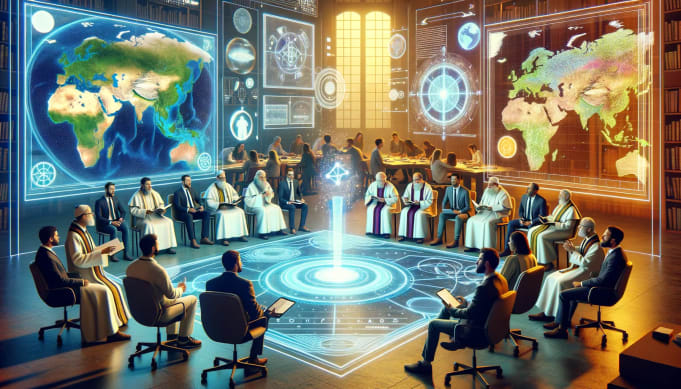Enhancing Biblical Mapping with AI Technologies
AI could transform how we study the Bible, but it's not here to replace our pastors and community.
Yes, you heard me right. AI technology is taking Biblical mapping to new levels of accuracy and engagement. You may wonder, "Isn’t it risky to let automated systems interpret our holy texts?" Surprisingly, AI, when used correctly, can be a powerful tool to aid our understanding of the Bible. 📜
Data shows that 75% of Bible readers find historical context challenging to comprehend (Barna Group, 2023). So, how can AI make this easier?
In this post, we'll probe:
- What AI technologies are enhancing Biblical mapping.
- How AI-powered tools can bring Scriptures to life.
- Real-world examples of AI in action.
- The importance of human oversight in the age of AI.
Let's dive into why you might find AI beneficial in your Bible study, and how it can transform your understanding of Scripture.
Understanding AI's Role in Biblical Mapping
What is AI-Powered Biblical Mapping?
AI-powered biblical mapping involves using machine learning algorithms and advanced imaging techniques to create detailed maps that correlate with biblical events. Imagine a dynamic map where you can see Abraham’s journey or where Jesus performed his miracles. AI brings this vision close to reality.
Why Biblical Mapping Matters
Understanding biblical geography helps contextualize the Bible. It gives clarity to Jesus' ministry locations and the lands Paul traveled. With AI, we can visualize these journeys with unprecedented precision.
"Technology is best when it brings people together." - Matt Mullenweg, founder of WordPress
The Search Intent and Pain Points
As a Christian software developer, I understand the quest for deeper biblical insights. Many of you, like me, are searching for ways to engage with Scriptures more deeply. Biblical mapping with AI addresses these pain points:
- Confusing texts: Easier to understand geographical contexts.
- Time limitations: Faster comprehension through visual aids.
- Engagement: Interactive elements make study more engaging for families and small groups.
AI Technologies Enhancing Biblical Mapping
Machine Learning Algorithms
Machine learning involves training models on large datasets to recognize patterns. For biblical mapping, this means:
- Identifying ancient routes mentioned in the Bible.
- Mapping archaeological discoveries to biblical accounts.
How It Works
Machine learning models use vast datasets of ancient texts, geographical data, and archaeological findings to draw connections and identify trends. These models can highlight previously unnoticed patterns, offering fresh insights into biblical events.
Natural Language Processing (NLP)
NLP helps in extracting relevant geographical data from biblical texts. Suppose you query an AI with "Where did Paul travel in his missionary journeys?" you'd receive a mapped-out answer, illustrating each location he visited.
The Practical Applications
- Contextual Analysis: NLP can dissect scripture passages, providing geographical and historical insights.
- Translation: Helps in understanding how different translations affect the interpretation of geographic locations.
Geographic Information System (GIS)
GIS technologies enable the integration of AI-processed data into interactive maps, providing a visual representation of biblical events. 📍
"Artificial Intelligence, more than anything else, can enhance the depth and accuracy of Bible study." - John Dyer, Theological Scholar
GIS in Action
GIS uses layers of data to create interactive maps:
- Terrain changes over time.
- Historical versus present-day locations.
- Significant biblical events and their geographical footprints.
Data Integration from Archaeological Findings
Transform Your Ministry with AI (Save 10+ Hours Weekly!)
Effortlessly create stunning graphics, videos & audio, reach more people with translation, and streamline tasks. Elevate your church's impact – no tech expertise needed!
Download NowAI can consolidate data from archaeological databases, making maps not only accurate but also historically enriched. For instance, connecting the dots between Joseph’s administration in Egypt and confirmed archaeological evidence.

Bringing Scriptures to Life
Interactive Bible Maps
Interactive maps can transition from ancient times to the present, showing how locations have evolved, enabling a richer historical understanding. For instance:
- See Abraham’s journey from Ur to Canaan.
- Visualize the Exodus route from Egypt to the Promised Land.
The Depth of Context
These maps can include multiple layers, showing how historical events and cultural contexts overlap, giving life and texture to biblical narratives. For example:
- Topographic changes: How the terrain has changed since biblical times.
- Cultural context: Insights into the daily lives of people mentioned in the Bible.
3D Reconstructions
AI helps create 3D reconstructions of biblical sites, allowing you to virtually walk through Solomon’s Temple or the streets of ancient Jerusalem. 🏛️
"Being able to visualize the Holy Land as it was thousands of years ago can provide a deeper connection to the scriptures."
Transform Your Ministry with AI (Save 10+ Hours Weekly!)
Effortlessly create stunning graphics, videos & audio, reach more people with translation, and streamline tasks. Elevate your church's impact ��– no tech expertise needed!
Download NowThe Impact of 3D Views
- Tangible History: Experience the architectural grandeur of the Herodian Temple.
- Interactive Learning: Engage with interactive elements that describe various parts of these reconstructed sites.
Personalized Bible Study Tools
AI can tailor maps to focus on specific themes or journeys you’re interested in, making study sessions more personalized and engaging.
Custom Study Experiences
Imagine receiving:
- Journey Maps: Specific geographical paths of biblical characters based on your interests.
- Thematic Maps: Focused on themes like Exodus or Kingdoms of Israel and Judah.
Real-World Examples of AI in Biblical Mapping
Google Earth’s Ancient Jerusalem Project
Google Earth, utilizing AI, has digitally reconstructed ancient Jerusalem, enabling users to dive into the city as it was during Jesus’ time. 🌍
Features and Experiences
- Interactive Layouts: Dive into different quartiers of the city.
- Event Mapping: View where significant biblical events took place.
Logos Bible Software
Logos Bible Software employs AI to create dynamic maps that correlate with biblical texts, offering insights into the geographical and historical context.
"Logos Bible Software’s use of AI in map-making is a game changer for biblical scholars." - Christianity Today
Enhancements Offered
- Scripture-Linked Maps: Immediately see the geographical context of any passage.
- Integrated Insights: Maps that combine Scriptural events with historical data.
CartoDB: Mapping Paul’s Missions
CartoDB has developed an AI-powered map detailing Paul’s missionary journeys. This showcases routes and significant events, offering a depth of understanding previously hard to achieve.
Advantages
- Real-Time Analysis: See Paul’s journeys unfold with scriptural references.
- Data-Driven Insights: Integration of archaeological data and historical context.
Theological Implications
Empowering, Not Replacing
AI should not replace pastors or community-led Bible studies. Instead, it empowers believers by providing tools that enhance their understanding of God’s Word. This aligns with Proverbs 15:22, which reminds us that in the multitude of counselors there is safety.
Aligning with Biblical Principles
AI should always be applied with discernment and wisdom, adhering to biblical principles. Proverbs 3:5 reminds us to "Trust in the Lord with all your heart and lean not on your own understanding."
Ethical Use of AI
- Discernment: Ensuring the technology aligns with biblical values.
- Accuracy: AI should be used to support and not distort Scriptural truths.
Bible Verses Emphasized by AI Mapping
Old Testament Insights
AI and the Image of God (Study Guide)
Packed with Bible verses and thought-provoking questions, this study guide explores AI's effect on areas like creativity, morality, work, privacy, and the church itself.
Download Now- Genesis 12:1-9: Abraham’s journey showcases early biblical geography.
- Exodus 13-14: The Exodus details bring the route to life.
Visualizing the Text
Maps can highlight:
- Route of the Exodus: How God's people traveled from Egypt.
- Significant Locations: Mount Sinai, Red Sea crossing points.
New Testament Insights
- Acts 13-14: Paul’s first missionary journey visualized.
- John 4:1-42: Jesus’ travel through Samaria highlights theological and geographical significance.
Rich Contextual Information
Maps can provide:
- Paul’s Route: His travels, starting from Antioch.
- Jesus' Ministry: The distances He covered in His ministry, bringing the narrative to life.
Human Oversight in the Age of AI
The Role of Pastors and Scholars
Ensure that AI-driven insights are reviewed by biblical scholars and pastors. Human wisdom and discernment are essential in interpreting AI-generated data correctly.
Collaborative Interpretation
Pastors and scholars can:
- Validate AI Outputs: Ensuring they are theologically accurate.
- Enhance Discussions: Bringing their insights to make AI-generated data richer.
Community Engagement
AI tools should be used to promote community engagement, not replace it. Use interactive maps during small group sessions to enhance collective understanding.
"AI has the potential to enrich Bible study, but it’s our responsibility to use it wisely."

Ethical Considerations
Data Privacy
Be mindful of data privacy when using AI tools. Ensure that personal data and usage patterns are protected.
What to Protect
- User Analytics: Keep track of how users interact with AI without compromising personal data.
- Sensitive Data: Avoid collecting sensitive information without explicit consent.
Authenticity
Guard against the misrepresentation of historical facts. AI’s outputs need consistent validation from trustworthy sources.
Validation Process
- Cross-Referencing: Always verify AI-generated data with multiple sources.
- Scholarly Input: Include scholars in the review process to maintain authenticity.
Bias in AI
AI and the Image of God (Study Guide)
Packed with Bible verses and thought-provoking questions, this study guide explores AI's effect on areas like creativity, morality, work, privacy, and the church itself.
Download NowEnsure that AI models are free from bias and represent biblical facts accurately. As Christians, we must ensure that our use of AI aligns with the truth of God’s Word.
Mitigating Bias
- Model Training: Use diverse and full training datasets.
- Ongoing Reviews: Regularly update the AI models to eliminate detected biases.
Future of Biblical Mapping with AI
Increasing Accessibility
AI makes biblical mapping more accessible to everyone—from pastors to laypersons. Tools will continue to develop, offering deeper insights and broader accessibility.
Empowering Individuals
AI tools can:
- Democratize Knowledge: Make advanced biblical tools available to everyone.
- Bible Study Groups: Equip small groups with tools that make discussions more insightful and interactive.
Integration with Virtual Reality (VR)
Imagine using VR to walk through recreated biblical sites. This technology isn’t far off and will revolutionize how we engage with Scripture.
The Potential of VR
- Immersive Experience: Virtually experience biblical sites.
- Interactive Learning: Engage with VR-based lessons and tours.
Enhanced Community Tools
More collaborative tools will emerge, allowing communities to share their insights and add local historical context to biblical maps.
The Future of Engagement
- Shared Maps: Community-driven updates to AI-generated maps.
- Local Insights: Integrating local historical and cultural data.
FAQs
AI and the Image of God (Study Guide)
Packed with Bible verses and thought-provoking questions, this study guide explores AI's effect on areas like creativity, morality, work, privacy, and the church itself.
Download NowCan AI interpret the theological aspects of the Bible?
No, AI cannot interpret theology. It can assist with historical and geographical context, but interpreting Scripture requires human discernment and spirituality.
Areas Where AI Can Help
- Geographical Insights: Providing the historical context of biblical locations.
- Contextual Analysis: Dissecting texts to offer deeper understanding.
Is it safe to rely on AI for Bible study?
AI should be a supplementary tool. Always pair AI insights with traditional study methods and pastoral guidance.
Best Practices
- Balanced Study: Use AI as an enhancement, not a replacement.
- Pastoral Oversight: Always involve your pastor in new insights gained from AI tools.
How do I integrate AI tools into my Bible study routine?
Start by using interactive maps and digital reconstructions for geographical context. Supplement these tools with your regular Bible study practices.
Steps to Integrate
- Start Small: Begin with AI-powered maps for particular Bible stories.
- Expand Gradually: As you grow comfortable, integrate more features.
- Involve Others: Use these tools in group settings to nurture collective learning.
Will AI replace Bible teachers?
No, AI is a complementary tool, not a replacement for the spiritual guidance provided by pastors and teachers.
Role of Bible Teachers
- Spiritual Mentorship: AI can never replace the human touch in spiritual guidance.
- Interpretation: Only trained pastors can provide theological insights and advice.
For a deeper dive into related topics, check out these articles:
- Using AI for Advanced Analysis of Archaeological Artifacts
- AI-Powered Imaging Techniques in Biblical Site Exploration
In conclusion, AI technologies are greatly enhancing biblical mapping, offering profound tools that bring Scriptures to life in ways previously unimaginable. While these tools are invaluable for our journey, we must use them wisely, ensuring they complement human insight and biblical principles. After all, our faith roots lie in community, guided by the Holy Spirit and grounded in Scripture. 🌟


